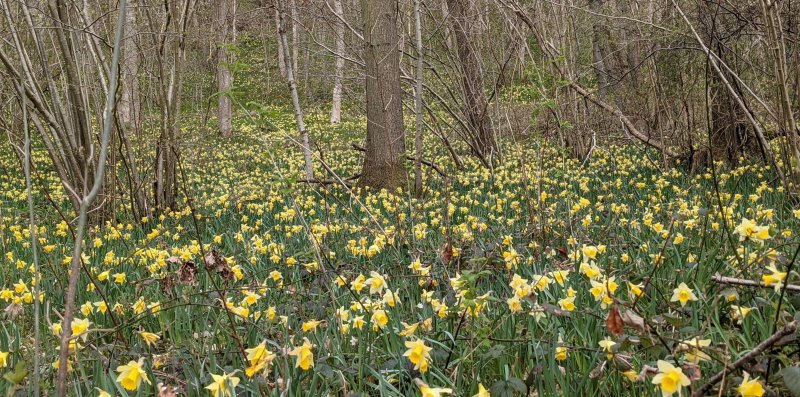

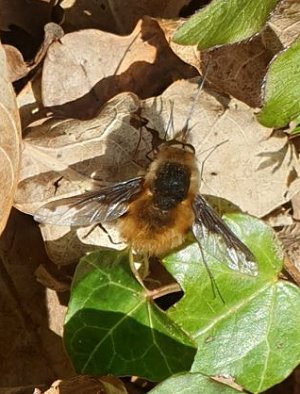
A small group of Ryenats members met in Appleton for a botanical walk. This roughly followed the route for the 2009 trip through the woods; as on that trip we had permission from Jonanthan and Madge Allison to explore the woods – a big thank you to them. It was sunny but cold which restricted the insects we saw (basically to a couple of ladybirds and a bee-fly (left) – this remarkable insect has a proboscis as long as the rest of its body, and looks like a miniature humming bird as it hovers in front of nectar-bearing flowers. Its life-cycle is rather grisly as it parasitises the larvae of mining bees, essentially eating them from the inside – see this article from the Guardian Country Diary.
We found the leaves on the Yellow Star of Bethlehem but no flowers this time (cf. 2009 “ ...small colony of the Gagea right at the top of the steep slope alongside the footpath, but sadly there was only one plant in flower, and that over its best. The leaves are similar to those of bluebells but finer and with a characteristic ‘hooded’ tip, and each individual bulb tends to have only one – and one flowering shoot. Interestingly it was growing close to an expanse of the fascinating moschatel or town hall clock (Adoxa moschatellina) just as it does at Kirkdale near the railway viaduct.” The moschatel is still there, as are Goldilocks buttercups, wood anemones, dog’s mercury and other woodland flowers. There is also a good spread of wild daffodils, especially a little further south in Hall Bank Wood. We noticed that some of the anemones and wood sorrel flowers were deep pink/purple: it is unclear if this is genetic, or reflects the soil chemistry, or indeed somethng else! There is a tendency for the anemones at least to darken as they age.
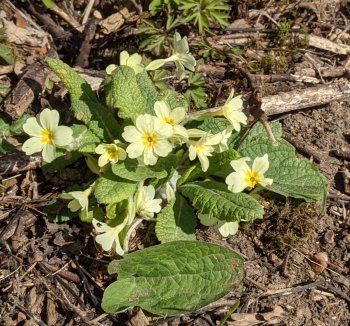 Primrose | 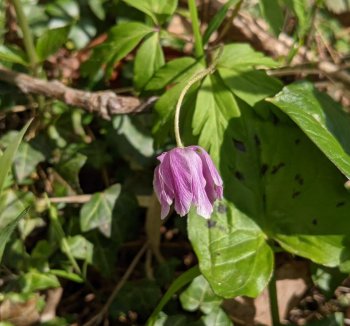 Wood anemone, pink variant |
The re-starting of coppicing mentioned in the 2009 article has indeed led to an opening up of the canopy and thus a profusion of wild flowers. Woodland is constantly changing even though we think of it as constant. Sensitive management is very important, and these woods show the benefits of that. We did not see the toothwort this time, I suspect we were too early as this is a very late spring. Or perhaps we just didn’t look carefully enough!
Comparing the plants lists we did not have as many this year, no doubt as we lacked the combined expertise of Nan Sykes and Gordon Simpson. One puzzle is that we found a violet that appeared to be Hairy, not Sweet, along the bottom edge of the wood roughly opposite Ridings Barn. I was expecting to find Sweet violets with which to compare this difficult plant, but we did not (and I also failed to take a photo of it). They did not appear to have any perfume, but it was a cold day and that sometimes means you don’t catch the scent! If only Nan could have been there.... The violet I did photograph was Common dog violet, seen here with wood anemones, ivy leaves and dog’s mercury leaves to the left.
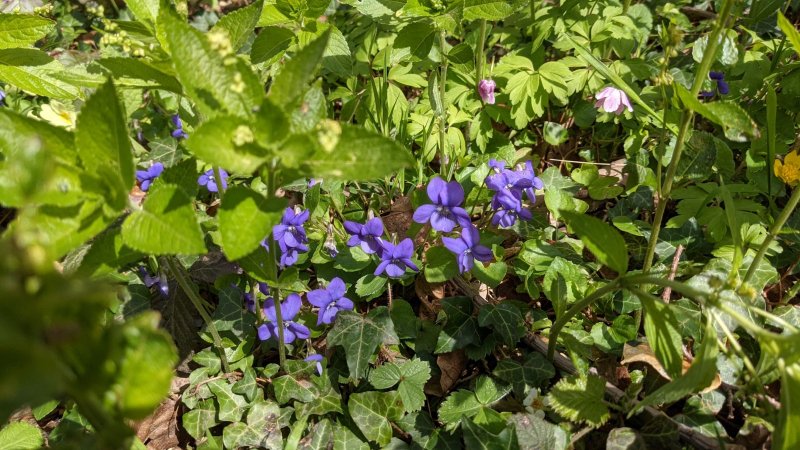
We saw two species of woodrush (which look rather like sedges but the leaves are hairy on both sides) – the large and common Greater woodrush (Luzula sylvatica) and the much smaller and more delicate Hairy woodrush (L. pilosa), a name that always seems contradictory as it is probably the least hairy woodrush we have! (below right)
Chiffchaff We did not see any butterflies, but a 7-spot ladybird was recorded, along with the amazing bee-fly (see above).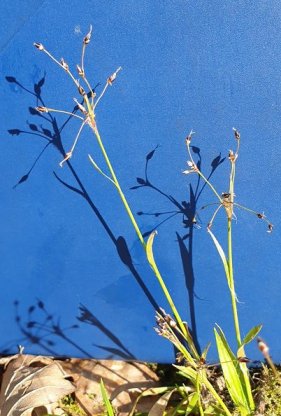
Birds
Yellowhammer
Rook
Buzzard
Pheasant
Redleg
Robin
Mallard flying over
Coal tit
Pigeon
Dunnock
Nuthatch
Wren
Insects
Plants
| © Ryedale Natural History Society 2021, Photos © Gill Smith, Richard Crossley 2021 |